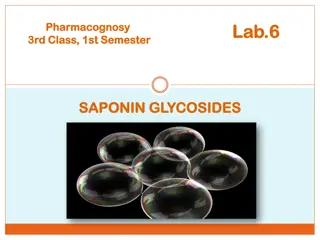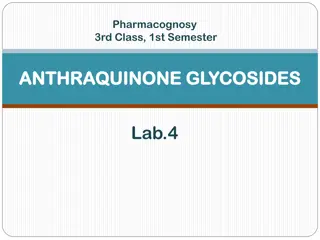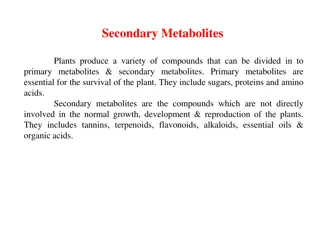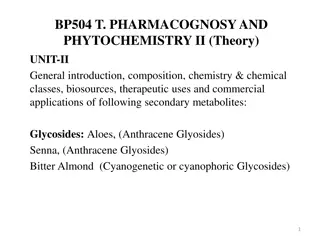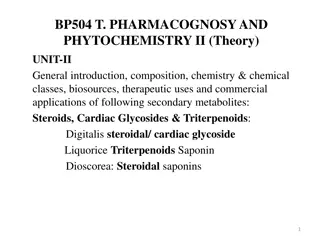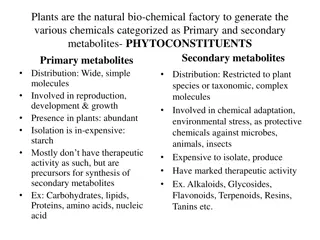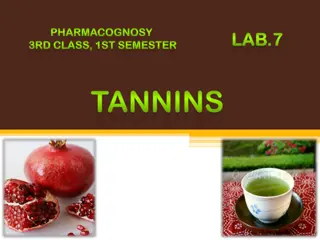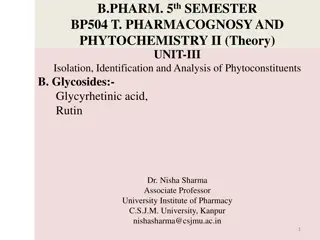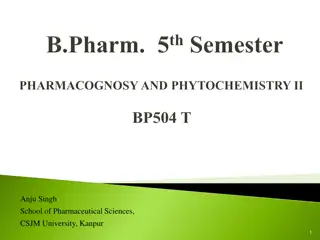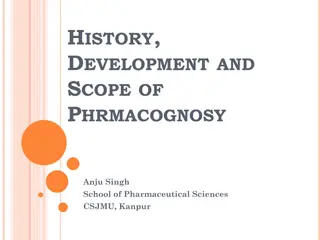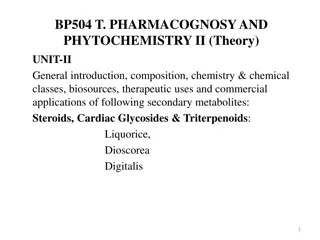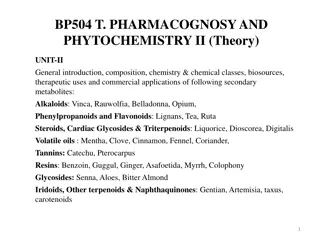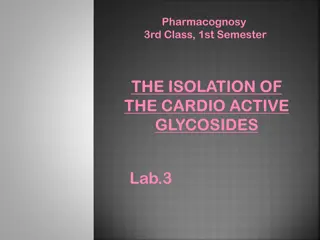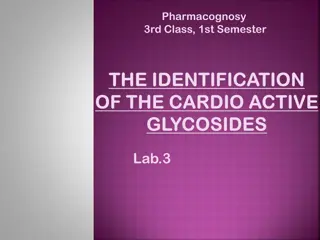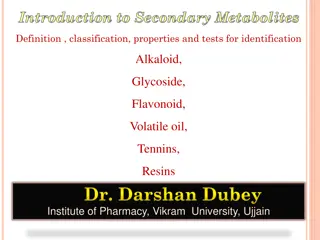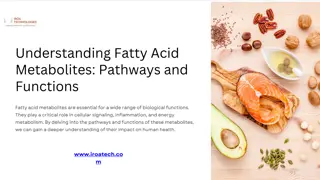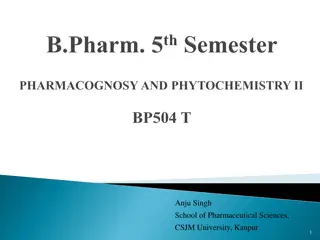Understanding Glycosides: Secondary Metabolites in Pharmacognosy
Glycosides are naturally occurring compounds with sugar and non-sugar components. They are characterized by glycosidic bonds and can be chemically separated. These compounds exhibit various physical and chemical properties, including solubility, taste, and optical activity. Classification based on glycone and glycosidic linkage further categorizes glycosides into different groups. Understanding the properties and classifications of glycosides is essential in the field of pharmacognosy and phytochemistry.
Download Presentation

Please find below an Image/Link to download the presentation.
The content on the website is provided AS IS for your information and personal use only. It may not be sold, licensed, or shared on other websites without obtaining consent from the author. Download presentation by click this link. If you encounter any issues during the download, it is possible that the publisher has removed the file from their server.
E N D
Presentation Transcript
B.PHARM. 4THSEMESTER BP405 T. PHARMACOGNOSY AND PHYTOCHEMISTRY I (THEORY) UNIT-IV Introduction to Secondary Metabolites Glycosides Dr. Nisha Sharma Director School of Pharmaceutical Sciences (University Institute of Pharmacy) C.S.J.M. University, Kanpur nishasharma@csjmu.ac.in 1
GLYCOSIDES Glycoside- is a group of naturally occurring complex compd. sugar part (glycone)+ non sugar part (aglycone) = Glycoside Bond joining is glycosidic bond, formed b/w hemiacetal group of a saccharide and -OH group of an alcohol. The glycone and aglycone portions can be chemically separated by hydrolysis in the presence of acid. There are also numerous enzymes that can form and break glycosidic bonds. Chemically they are acetyl or sugar ethers formed by interaction of OH of non sugar & sugar, with loss of water. OH of aglycone- alcoholic/phenolic/ amines Sugars are of D glucose, others- mannose, galactose, rhamnose, digitoxose, cymarose etc. 2
PROPERTIESOF GLYCOSIDES Physical Properties 1. Crystalline/ amorphous, solid, non volatile 2. Solubility: sol. In polar solvents Exceptions: Resin glycoside Insoluble in other organic solvents CHCL3, Ether Aglycone solubility- Soluble in non polar organic solvent (C6H6, Ether) 3. Optically active ,Laevo form active 4. Bitter taste except Glycyrrhizin, stevia 5. More the sugar units, more is polar solubility Chemical Properties 1. Hydrolysis: Hydrolysed by water, mineral acids, & enzymes Glycosides Aglycone + Glycone Exception: C glycosides are stable, undergo oxidative hydrolysis (Aloin) 2. Alkali Hydrolysis: Strong & mild alkali hydrolyses ether group. Opens lactone ring (cardiac glycosides) 3. Enzymatic hydrolysis: Emulsin hydrolyses glycoside Maltase, invertase hydrolyse glycoside In plants form exist 3
CLASSIFICATION On the Basis of Glycone Glycone group of a glycoside is glucose glucoside; mif it is fructose fructoside; If glucuronic acid glucuronide, etc. On the Basis of Glycosidic Linkage 1. O-glycosides: Sugar molecule is combined with phenol or OH group of aglycon, for example, higher plants: senna, rhubarb, Amygdaline, Salicin, cardiac glycosides, anthraquinone glycosides like sennosides etc. Glycone O H+HO aglycone Glycone O Aglycone + H2O 2. N-glycosides: Sugar molecule is combined with N of the NH (amino group) of aglycon, for example, nucleosides Glycone OH+H N aglycone Glycone N Aglycone + H2O 3. S-glycosides: Sugar molecule is combined with the S or SH (thiol group) of aglycon, Isothiocyanate glycosides: for example, Sinigrin from black mustard Glycone OH+H S aglycone Glycone S Aglycone + H2O 4. C-glycosides: Sugar molecule is directly attached with C atom of aglycon, for example, Anthraquinone glycosides like Aloin, Barbaloin, Cascaroside and Flavone glycosides, etc.cochineal coloring matter- carminic acid Glycone OH+H C aglycone Glycone C Aglycone + H2O 4
CLASSIFICATIONONTHE BASISOF AGLYCONE SN 1 2 3 4 CLASS Anthraquinone glycosides Sterols or cardiac glycosides Saponin Glycosides Cyanogenetic & Cyanophoric glycosides Thiocyanate & isothiocyanate gycosides Flavone glysosides Aldehyde glycoside Phenol glycoside Steroidal glycoside Bitter & Miscellaneous Glycosides EXAMPLE Senna, Aaloe, Rhubarb etc Digitalis, Thevetia, Squill etc. Dioscorea, Liqurice, Ginseng Bitter almod, wild cherry barks 5 Black mustard 6 7 8 9 10 Ginko Vanilla Bearberry Solanum Gential, Piccrohiza, Chirata 5
IDENTIFICATION TEST Chemical Tests for Anthraquinone Glycosides Borntrager s test 1 gm of drug + 5 10 ml dil. HCl, boil on water bath for 10 min, filter. extract filterate with CCl4/ benzene. Add equal amount of NH3, shake. Pink or red color in ammonical layer due anthraquinone moiety. Modified borntrager s test 1 gm of drug +5 ml dil. HCl + 5 ml FeCl3 (5% w/v). Boil for 10 min on water bath, cool and filter, extract filterate with CCl4/ benzene, add equal volume of NH3 solution formation of pink to red colour due to anthraquinone moiety. This is used C-type of anthraquinone glycosides. Chemical Tests for Saponin Glycosides Haemolysis test A drop of blood on slide+ mix with few drops of aq. Saponin solution RBC s rupture in presence of saponins. Foam test 1 gm drug + 10 20 ml H2O, shake for few minutes frothing persists for 60 120 s in presence of saponins 6
IDENTIFICATION TEST FOR STEROID & TRITERPENOID GLYCOSIDE Libermann burchard test Evaporate alcoholic extract of drug to dryness, extract with CHCl3 + few drops of acetic anhydride followed by conc. H2SO4from sides of test tube violet to blue colored ring at the junction of two liquid, indicate the presence of steroid moiety. Salkowaski test Evaporate alcoholic extract of drug to dryness, extract with CHCl3 + conc. H2SO4 from sidewall of test tube to extract yellow colored ring at the junction of two liquid, which turns red after 2 min, indicate the presence of steroid moiety. Antimony trichloride test Evaporate alcoholic extract of drug to dryness, extract with CHCl3 + saturated solution of SbCl3 in CHCl3containing 20% acetic anhydride Formation of pink color on heating indicates presence of steroids and triterpenoids. Zimmermann test Meta dinitrobenzene solution + alcoholic solution of drug containing alkali + heat violet color in presence of keto steroid. 7
IDENTIFICATION TEST FOR CARDIAC GLYCOSIDE Keller-kiliani test Alcoholic extract of drug + equal vol. of H2O + 0.5 ml of strong lead acetate solution shake, filter. Filtrate + eq. vol. CHCl3. Evaporate CHCl3 extract to dryness, Dissolve residue in 3 ml of gl. CH3COOH +few drops of FeCl3 solution. Transfer resultant solution to a TT containing 2 ml conc. H2SO4 Reddish brown layer is formed, turns bluish green after standing due to presence of digitoxose. Legal test Alcoholic extract of drug + equal vol. of H2O + 0.5 ml of strong lead acetate solution , shake, filter. Filtrate + eq. vol. CHCl3. Evaporate CHCl3 extract to dryness, Dissolve residue in 2 ml of pyridine and sodium nitropruside 2 ml + NaOH to make alkaline pink color in presence of glycosides or aglycone moiety. Baljet test Thick section of leaf of digitalis or the part of drug containing cardiac glycoside + sodium picrate solution yellow to orange color in presence of aglycones or glycosides. 3,5-dinitro benzoic acid test Alcoholic sol. Drug + drops of NaOH+ 2% sol. of 3,5-dinitro benzoic acid pink color indicates presence of cardiac glycosides. 8
TEST FOR COUMARIN GLYCOSIDES FeCl3 test Conc. alcoholic extract of drug + few drops of alcoholic FeCl3solution deep green color, turns yellow on addition of conc. HNO3 presence of coumarins Fluorescence test Alcoholic extract of drug + 1N NaOH (1 ml each) blue-green fluorescence shows presence of coumarins. Chemical Tests for Cynophoric Glycoside Sodium picrate test Powdered drug + moistened with H2O + drops of conc. H2SO4 in C Flask Filter paper impregnated with sodium picrate solution followed by Na2CO3 sol. trapped on the neck of flask using cork brick red color due to volatile HCN in presence of cynophoric glycosides 9
Chemical Tests for Flavonoid Glycosides: Ammonia test Dip Filter paper in alcoholic sol. of drug + expose to NH3 yellow spot filter paper Shinoda test alcoholic extract of drug + Mg turning + dil. HCl red color (Flavonoids) alcoholic extract of drug + Zn turning +dil. HCl deep red to magenta colour, presence of dihydro flavonoids. Vanillin HCl test Vanillin HCl + alcoholic sol. of drug pink color due to presence of flavonoids. 10
REFERENCES Pharmacognosy, C.K. Kokate, A.P. Purohit, S.B. Gokhale, 54th Ed. 2017, Nirali Publication, New Delhi Text Book of Pharmacognosy & Phytochemistry, Shah & Seth, 2010, 1st Ed. Elsevier, India 11



